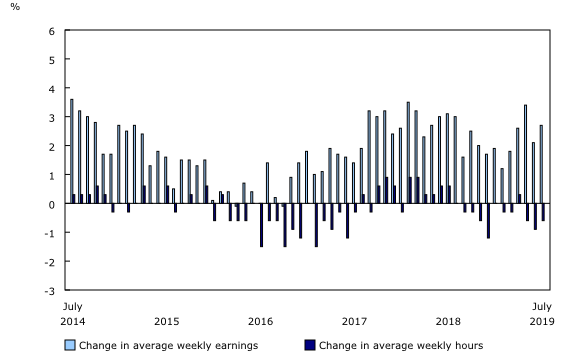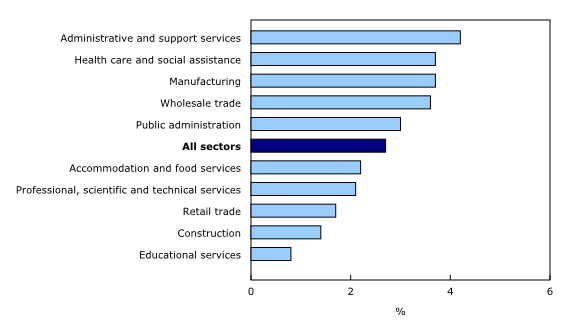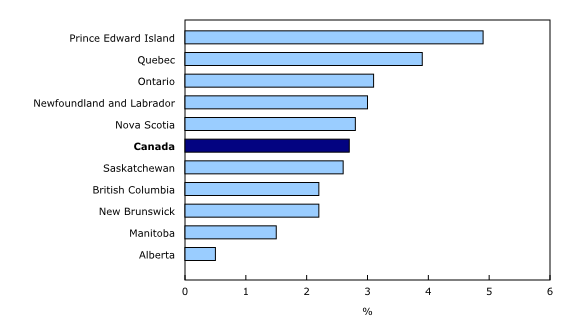Payroll employment, earnings and hours, July 2019
Archived Content
Information identified as archived is provided for reference, research or recordkeeping purposes. It is not subject to the Government of Canada Web Standards and has not been altered or updated since it was archived. Please "contact us" to request a format other than those available.
Released: 2019-09-26
$1,026.96
July 2019
2.7% 
(12-month change)
$1,060.70
July 2019
3.0% 
(12-month change)
$873.88
July 2019
4.9% 
(12-month change)
$897.61
July 2019
2.8% 
(12-month change)
$929.47
July 2019
2.2% 
(12-month change)
$963.92
July 2019
3.9% 
(12-month change)
$1,049.13
July 2019
3.1% 
(12-month change)
$952.66
July 2019
1.5% 
(12-month change)
$1,035.63
July 2019
2.6% 
(12-month change)
$1,155.10
July 2019
0.5% 
(12-month change)
$993.66
July 2019
2.2% 
(12-month change)
$1,167.08
July 2019
3.9% 
(12-month change)
$1,465.63
July 2019
4.9% 
(12-month change)
$1,431.75
July 2019
2.7% 
(12-month change)
Non-farm payroll employees earned an average of $1,027 per week in July, up 0.5% from the previous month. On a year-over-year basis, earnings were up 2.7%.
In general, changes in weekly earnings reflect a number of factors, including wage growth; changes in the composition of employment by industry, occupation and level of job experience; and average hours worked per week.
Non-farm payroll employees worked an average of 32.6 hours per week in July, little changed from June but down from 32.8 hours in July 2018.
To explore the most recent results of the Survey of Employment, Payrolls and Hours in an interactive format, visit the "Earnings and payroll employment in brief: Interactive app."
Earnings up in eight of the largest industrial sectors
Year over year, average weekly earnings increased in 8 of the 10 largest industrial sectors, led by administrative and support services. At the same time, earnings were little changed in construction and educational services.
In administrative and support services, average weekly earnings were up 4.2% to $821 in July. Services to buildings and dwellings, and employment services were the largest contributors to the growth. Most of the increase in this sector occurred between November and March.
For payroll employees in health care and social assistance, earnings rose 3.7% to $935. The majority of the year-over-year growth occurred in ambulatory health care services. Payroll employment in this sector has been on a long-term upward trend. Second quarter 2019 data from the Job Vacancy and Wage Survey (JVWS) showed that the number of job vacancies in this sector was up 8.4% compared with the second quarter of 2018.
On a year-over-year basis, earnings in manufacturing grew 3.7% to $1,122. This increase was driven by transportation equipment manufacturing and fabricated metal product manufacturing. Most of the earnings growth in the sector occurred in the fourth quarter of 2018.
Compared with 12 months earlier, earnings in wholesale trade were 3.6% higher in July, at $1,230. Machinery, equipment and supplies wholesalers and building material and supplies wholesalers contributed the most to the increase.
Average weekly earnings in public administration were up 3.0% to $1,345 in July. Growth was spread across all subsectors.
In accommodation and food services, earnings increased 2.2% to $418. Virtually all of the rise came from the full-service restaurants and limited-service eating place industry.
Year over year, earnings in professional, scientific and technical services were up 2.1% to $1,421 in July. The high-paying computer systems design and related services industry contributed the most to the growth.
In retail trade, earnings were 1.7% higher in July, at $617. Motor vehicle and parts dealers, and health and personal care stores accounted for most of the rise.
Earnings up in nine provinces
Compared with July 2018, average weekly earnings increased in nine provinces, with Prince Edward Island leading the gains for the second consecutive month. Little change was recorded in Alberta.
On a year-over-year basis, earnings in Prince Edward Island were up 4.9% to $874 in July. Gains were driven by educational services, wholesale trade, and professional, scientific and technical services. Earnings in the province have been on an upward trend since March.
Average weekly earnings in Quebec were 3.9% higher in July, at $964. Health care and social assistance and manufacturing were the largest contributors to the growth. Based on results from the Labour Force Survey (LFS), the unemployment rate in Quebec reached a historic low in the summer of 2019. At the same time, second quarter 2019 data from the JVWS showed that the number of job vacancies in the province increased 20.7% on a year-over-year basis.
The earnings of payroll employees in Ontario were up 3.1% to $1,049 in July. Professional, scientific and technical services and health care and social assistance contributed the most to the increase.
In Newfoundland and Labrador, earnings rose 3.0% to $1,061. Mining, quarrying, and oil and gas extraction, and construction were the two largest contributors to the year-over-year growth.
In Nova Scotia, earnings increased 2.8% to $898 in July, with the gains spread across most sectors.
Compared with July 2018, earnings in Saskatchewan grew 2.6% to $1,036. Health care and social assistance, and transportation and warehousing contributed the most to the rise.
Compared with 12 months earlier, earnings in British Columbia were 2.2% higher in July, at $994. Educational services was the largest contributor to the growth. Most of the increase in the province occurred between March and May.
Year over year, average weekly earnings in New Brunswick rose 2.2% to $929. Manufacturing contributed the most to the growth.
In Manitoba, average weekly earnings grew 1.5% to $953. Transportation and warehousing, and finance and insurance were the largest contributors to the growth.
Earnings in Alberta were little changed at $1,155 in July, as increases in several sectors were offset by declines in construction and mining, quarrying and oil and gas extraction.
Payroll employment up from June to July
The number of non-farm payroll employees increased by 75,400 from June to July, with the largest growth occurring in educational services, and accommodation and food services. At the same time, employment was down slightly in retail trade, and real estate and rental and leasing. In addition, employment decreased in forestry, logging and support; this decline coincided with recent mill shutdowns in British Columbia.
Year over year, the number of payroll employees rose by 385,500 (+2.3%). The largest increases were observed in health care and social assistance (+75,100 or +3.8%), educational services (+56,200 or +4.3%), and professional, scientific and technical services (+47,200 or +5.1%). At the same time, payroll employment declined in mining, quarrying, and oil and gas extraction (-3,000 or -1.5%) and forestry, logging and support (-600 or -1.6%). Following 20 consecutive months of year-over-year decreases, employment was little changed in July in information and cultural industries.
Spotlight: Professional, scientific and technical services
Professional, scientific and technical services was one of the largest contributors to the year-over-year increase in average weekly earnings in July, based on the sector's growth in both earnings (+2.1%) and employment (+5.1%). This sector has nine industries, which cover a wide range of high-skilled jobs in areas such as law, accounting, architecture, engineering, scientific research, and computer systems design.
Close to one million people worked in professional, scientific and technical services in July, accounting for 5.8% of total payroll employment in Canada. The sector represented a similar proportion of payroll employment in 2001, when comparable data became available.
In July 2019, the share of workers in professional, scientific and technical services was highest in Ontario (6.5%). This province accounted for 44.0% of all payroll employment in professional, scientific and technical services, higher than the 38.9% of total national payroll employment Ontario accounted for overall.
In July, the average employee in professional, scientific and technical services—one of the most highly paid sectors since the beginning of the series—worked 36.3 hours per week, and earned $1,421. The largest industry in the sector, computer systems design and related services (26.8% of payroll employment), had some of the highest earnings, at an average of $1,606 per week. This industry was also the largest in the sector in 2001, though it represented a slightly smaller share of employment then, at 23.7%.
While payroll employment has grown since the beginning of the series in most industries within professional, scientific and technical services, this has not been the case for management, scientific and technical consulting services, where the share of payroll employment within the sector declined from 15.1% in January 2001 to 10.2% in July 2019.
Based on results from the LFS, women accounted for 43.0% of all employment in professional, scientific and technical services in 2018, up from 37.2% at the beginning of the series, in 1976.
Sustainable Development Goals
On January 1, 2016, the world officially began implementation of the 2030 Agenda for Sustainable Development—the United Nations' transformative plan of action that addresses urgent global challenges over the next 15 years. The plan is based on 17 specific sustainable development goals.
The Survey of Employment, Payrolls and Hours is an example of how Statistics Canada supports the reporting on the Global Goals for Sustainable Development. This release will be used to measure the following goals:


Note to readers
The Survey of Employment, Payrolls and Hours (SEPH) is produced by a combination of a census of approximately one million payroll deductions provided by the Canada Revenue Agency, and the Business Payrolls Survey, which collects data from a sample of 15,000 establishments. Federal, provincial and territorial public administration data are collected from various administrative records provided by these levels of government. The key objective of the SEPH is to provide a monthly portrait of the level of earnings and the number of jobs and hours worked by detailed industry at the national, provincial and territorial levels.
Estimates of average weekly earnings and hours worked are based on a sample and are therefore subject to sampling variability. This analysis focuses on differences between estimates that are statistically significant at the 68% confidence level. Payroll employment estimates are based on census of administrative data and are not subject to sampling variability.
Statistics Canada also produces employment estimates from its Labour Force Survey (LFS). The LFS is a monthly household survey, the main objective of which is to divide the working-age population into three mutually exclusive groups: the employed (including the self-employed), the unemployed, and those not in the labour force. This survey is the official source for the unemployment rate, and collects data on the socio-demographic characteristics of all those in the labour market.
As a result of conceptual and methodological differences, estimates of changes from the SEPH and LFS do differ from time to time. However, the trends in the data are quite similar. For a more in-depth discussion of the conceptual differences between employment measures from the LFS and SEPH, refer to section 8 of the Guide to the Survey of Employment, Payrolls and Hours (72-203-G).
Unless otherwise stated, this release presents seasonally adjusted data, which facilitate comparisons by removing the effects of seasonal variations. For more information on seasonal adjustment, see Seasonally adjusted data – Frequently asked questions.
Non-farm payroll employment data are for all hourly and salaried employees, as well as for the "other employees" category, which includes piece-rate and commission-only employees.
Unless otherwise specified, average weekly hours data are for hourly and salaried employees only and exclude businesses that could not be classified to a North American Industry Classification System (NAICS) code.
All earnings data include overtime pay and exclude businesses that could not be classified to a NAICS code. Earnings data are based on gross taxable payroll before source deductions. Average weekly earnings are derived by dividing total weekly earnings by the number of employees.
With each release, data for the current reference month are subject to revision. Data have been revised for the previous month. Users are encouraged to request and use the most up-to-date data for each month.
Real-time data tables
Real-time tables 14-10-0357-01, 14-10-0358-01, 14-10-0331-01 and 14-10-0332-01 will be updated on October 7.
Next release
Data on payroll employment, earnings and hours for August will be released on October 31.
Products
Job Vacancy Statistics (5202) from the Survey of Employment, Payrolls and Hours for June are now available.
More information about the concepts and use of the Survey of Employment, Payrolls and Hours and Job Vacancy Statistics is available in the Guide to the Survey of Employment, Payrolls and Hours (72-203-G).
The product "Earnings and payroll employment in brief: Interactive app" (14200001) is now available. This interactive visualization application provides a comprehensive picture of the Canadian labour market using the most recent data from the Survey of Employment, Payrolls and Hours. The estimates are seasonally adjusted and available by province and largest industrial sector. Historical estimates, going back 10 years, are also included. The interactive application allows users to quickly and easily explore and personalize the information presented. Combine multiple provinces and industrial sectors to create your own labour market domains of interest.
Contact information
For more information, or to enquire about the concepts, methods or data quality of this release, contact us (toll-free 1-800-263-1136; 514-283-8300; STATCAN.infostats-infostats.STATCAN@canada.ca) or Media Relations (613-951-4636; STATCAN.mediahotline-ligneinfomedias.STATCAN@canada.ca).
- Date modified:




